TRADITIONAL TIBETAN MEDICINE
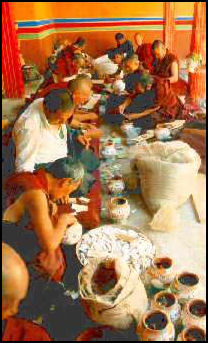
Tibetan medicine pharmacy
Tibetan medicine, known as "gsowa rigpa," (“knowledge of healing") is said to be based on the teaching of Buddha but is also based on traditions that existed in the Himalayas and in South Asia before Buddhism took hold in the region. Traditional Tibetan medicine (TTM) is similar to other traditional Asian medicines. It is heavily influenced by Ayurvedic traditions introduced from India and is based on the belief that the human body balances three kinds of internal energies. It also combines Chinese medicine, Himalayan folk cures with Buddhist theology and its concept of "three poisons." A report issued by the Beijing-based China Tibetology Research Center in March 2009 said the output value of Tibet's medical and pharmaceutical industry registered a 1.6-fold increase from 2000 to 2008.
Rebecca R. French wrote: Tibetan medicine evolved over a thousand years into a series of nonintrusive techniques including listening to blood flow through the wrist, analysis of urine and anatomical parts, listening to the heart and lungs, questioning the patient, and administering carefully prepared herbal pills. The body is considered to be composed of various elements balanced by nutrition, religious practices, mental states, and relations with deities. The training process for physicians was long and often limited to monks. [Source: Rebecca R. French, e Human Relations Area Files (eHRAF) World Cultures, Yale University]
The goal of Tibetan medicine is to heal the spirit and restore equilibrium, harmony and balance to the body disrupted by the “Three Interior Poisons” — desire, anger and ignorance — through balanced nutrition, religious practices, mental states and relations with deities. Yuthok Yonten Gonpo, a famous 8th century Tibetan medical scientist, said movement was the essence of life in his book 'The Four-Volume Medical Code' which mainly talked about health care methods using qigong, sports and exercise/
Diseases and health problems are believed to be caused imbalances involving the “three humors” (the physical manifestations of the Three Poisons) — Lung (wind),mKris-pa (bile) and Bad-kan (phlegm)—“the seven body sustainers” and “three eliminators,” and the affect of 360 harmful male influences, 360 harmful female influences, and 360 harmful influences related to bad karma from the past. By one count there are 404 basic orders and 84,000 illnesses. Popular Tibetan remedies include caterpillar fungus, dried snow lotus and a heart treatment made from powdered coral. A Tibetan who sells these items on the street earns earned about $215 a month in the 2000s.
Good Websites and Sources: Tibetan Medicine.com tibetanmedicine.com ; Resource Guide on Tibetan Medicine ; Paper on Tibetan Astrology and Medicine berzinarchives.com ; Wikipedia article Wikipedia
See Separate Articles: TIBETAN HEALTH factsanddetails.com; HEALTH AND DISEASES AT HIGH ALTITUDES factsanddetails.com; many articles TIBETAN LIFE factsanddetails.com TIBETAN PEOPLE factsanddetails.com FOOD IN TIBET Factsanddetails.com/China
RECOMMENDED BOOKS: “Essentials of Tibetan Traditional Medicine” (Illustrated) by Thinley Gyatso, Chris Hakim Amazon.com; “The Tibetan Book of Health: Sowa Rigpa, the Science of Healing” by Nida Chenagtsang and Professor Robert Thurman PhD Amazon.com; “Medicine and Memory in Tibet: Amchi Physicians in an Age of Reform” by Theresia Hofer Amazon.com “High Altitude: Human Adaptation to Hypoxia” by Erik R. Swenson and Peter Bärtsch Amazon.com; “Travel Health Experience in High Altitude Destination: Case Studies of Sagarmatha National Park (Nepal) and Tibet (China)” by Ghazali Musa Amazon.com; “Ward, Milledge and West’s High Altitude Medicine and Physiology” by Andrew M Luks, Philip N Ainslie, et al. Amazon.com
History of Traditional Tibetan Medicine
According to the Chinese government: Tibetan medicine has a long history. Doctors of this school of medicine pay great attention to practical skills. They diagnose illnesses by observation, auscultation, smelling, interrogation and pulse feeling. They also know how to collect medicinal herbs and prepare drugs and are skilled in acupuncture, moxibustion and surgery. Tibetan doctors are especially outstanding in veterinary medicine. [Source: China.org china.org |]
Tibetan medical science rose during the period of the Tibetan king Song Tibetananbu to the king Chisongdezan, and was formed on the basis of Tibetan traditional medical theories while absorbing and drawing on the theories of Chinese and Indian medical science. [Source: Liu Jun, Museum of Nationalities, Central University for Nationalities, kepu.net.cn ~]
Traditional Tibetan Medicine (TTM) has been deemed one of the five great inventions by the Tibetan people (The Tibetan have 10 inventions: the five major ones are craftsmanship, medicine, phonology, Tibetan philosophy and Buddhism; the five minor ones are: rhetoric, lexics, studies of rhythm, drama and astrology). The conventional wisdom is that although TTM is influenced by and incorporates a number of medical philosophies and schools, it did not originate from India or China or some other place. Rather is was developed by Tibetan people that took its original form thousands of years ago to deal with diseases and health problems on the Tibetan Plateau. TTM is regarded as a unique medical system that caters to the specific needs of the unique natural, economic and cultural environments of Tibet. [Source: Chloe Xin, Tibetravel.org]
According to legend, around 300 B.C., the first Tibetan king—the legendary Niecizanbu—was about to ascend the throne and asked the great legendary sage Zila Gmayoude six questions. The fifth question was in regards to “poison”. The sage argued that was considered “poison” in Tibet was actually medicine. According to Lunbogatang the Tibetan people at that time were already aware of the medical functions of some plants, animals and minerals and had knew some complex detoxification approaches.
During the A.D. first century the advancement of agriculture and animal husbandry facilitated the discovery of many new medical raw materials in Tibet: for example, ghee refined from milk could be used to stop bleeding. In the centuries theat followed the development of TTM never stood still, thanks to the incorporation of numerous foreign influences from India, Kashmir, China and Cong (in today’s Xinjiang, China).
In the A.D. eighth century, the famous Tibetan doctor, Yuthok Nyingma Yonten Gonpo went to India to study Indian medicine. This knowledge greatly accelerated the development of Tibetan medical science. This doctor learned a lot from Chinese and Indian traditional medical science and incorporated his knowledge into the system of Tibetan medical science.
Its is said that the birthplace of Tibetan medicine is the Namye Valley, located in the Namye Township in southern Mainling County, Nyingchi Prefecture in east Tibet. Yuthok Nyingma Yonten Gonpo lived here, taught students and treated patients in the Namye Valley, a relatively wet and green region of Tibet. [Source: Chloe Xin, Tibetravel.org]
Ideas Behind Traditional Tibetan Medicine
Traditional Tibetan Medicine is based on the ideas that there are: A) three main factors in human body that are "Long" (breath), "Chiba" (internal heat) and "Peigen" (soil and water); B) there are seven basic substances: diet essence, flesh, blood, fat, bone, marrow and spirit; C) three kinds of excreta: shit, urine and sweat. Tibetans think that human's diseases are caused by influence of environment, climate, diet and daily life, and maladjustment of the three factors in human body. ~
The three main factors control the operation and change of the seven basic substances and the three kinds of excreta. 1) "Long" masters the function of vital energy, the state of the blood, the movement of limbs, the feeling of the five sense organs, transporting and decomposition of food, and reproducing function; 2) "Chiba" can produce thermal energy, mediate body temperature and complexion, control hunger, thirst, digestion, courage, insight and wisdom; and 3) "Peigen" transports liquid, mediates the proportion of fat and clean, manages mainly sense of taste, sleep, disposition. ~
Tibetans adopt four methods of diagnosis (observation, auscultation & olfaction, interrogation, and pulse feeling & palpation), and pay special attention to the change of coating on the tongue and the first urine in the morning. They divide diseases into two types: hot diseases and cold diseases, and they divide patients into three types: "Long", "Chiba", and "Peigen". Medicine treatment is divided into two kinds: oral medicine and medicine for external application. The principle of "cooling the hot" and "warming up the cold" is adopted when treating with oral medicine. Methods of treating externally are: acupuncture, bloodletting, cupping, stanching bleeding with hot butter, applying distiller's grains to affected parts of trauma. Commonly used medicines are mostly patent medicines compounded with many kinds of materia medica, and there are over 1400 kinds of materia medica altogether among which some are specialties of the Qinghai-Tibet Plateau. ~
There are many ancient Tibetan medical books and records. The "Four Medical Records" written by Yutou o Yundangongbu in the eighth century is the most famous among them. The book is divided into four parts, and it contains basic theories and clinical practice of different departments, including dissecting human body, development of embryo, pathogeny and pathology, treating principles, different clinical departments, prescription and medicine, diagnosis and treating apparatus. The popular edition at present has been revised and supplemented by generations of Tibetan doctors. Yutou is listed in the "nine famous doctors in Tibet" as the first one, and is called "the greatest doctor in the snowy area-king Yutuo".
Principles of Tibetan Medicine
Traditional Tibetan medicine is based on the "theory of three factors." The theory centers on the "seven substances" and "three excrements" of the human body. The three factors is explained in detail below. The seven substances include diet, blood, flesh, fat, bone, marrow, and seminal fluid; and the three excrements are sweat, urine and stool. When a person is in good health, the relations between the three factors, seven substances and three excrements are in good balance. Keeping balance is an important principle of traditional Tibetan medicine. [Sources: Tamdin Sither Bradley graduated from the Tibetan Medical and Astrological Institute in Dharamsala, [Source: Chloe Xin, Tibetravel.org]
Another important idea is : “Where there is poison, there is medicine”: As early as the ancient times, in their fight with nature, people living in the Tibet Plateau became knowledgeable about some characteristics and functions of herbs and hence began to use the herbs for therapies; they also came to know some medical functions of some animals during hunting. Then there comes the ancient medical theory “Where there is poison, there is medicine; medicine and poison are of coexistence, which can transform into each other”. This is considered as the earliest theory of Tibetan medicine.
Tibetan medicine states that everything within the universe is composed of five proto-elements: wind, earth, water, fire and space. Wind is responsible for movement; earth gives substance; water holds things together; fire heats or transforms; and space provides the living room for the creatures. Nothing can go without any of the five significant elements. The harmonious relationship between herbs and the environment are reasonably stated according to this medical theory.
Theory of Three Factors of Tibetan Medicine
According to theories of TTM, the human body's physiological functions are summed up in three major elements: 1) Nyipa sum - rLung (pronounced loong), 2) mKhris-pa and 3) Bad-kan. The basic theory of Tibetan medicine is to keep these three things in balance. The long-term causative factors of Nyipa sum are the three poisons of desire, hatred and delusion, which show how closely Tibetan medicine is connected with Buddhism. Because there is no equivalent translation for rLung, mKhris-pa and Bad-kan into Sanskrit, the original names are used. [Sources: Tamdin Sither Bradley graduated from the Tibetan Medical and Astrological Institute in Dharamsala, thangka.de ; Chloe Xin, Tibetravel.org]
The general description of rLung is that it is a subtle flow of energy and out of the five elements (air, fire, water, earth and space) that are most closely connected with air. However it is not simply the air that we breathe in and out or the wind in our stomachs. It goes much deeper than that. Suppose rLung is like a horse, the mind is like the rider; if there is something wrong with the horse, the rider will not be able to ride properly. Its description is that it is rough, light, cool, thin, hard and movable. The general function of rLung is to help growth, movement of the body, exhalation and inhalation and to aid the function of mind, speech and body. RLung helps to separate in our stomachs what we eat into nutrients and waste products. However its most important function is to carry the movements of mind, speech and body. The nature of rLung is both hot and cold.
Bad-kan roughly translated means phlegm is not the phlegm which comes from the chest; it refers to all the diseases connected with the cold nature called Bad-kan. From out of the five elements (air, fire, water, earth and space) it is related to both water and earth. The description of Bad-kan is oily, cool, heavy, blunt, smooth, steady and sticky. The main function of Bad-kan is to sustain the bodily liquids. It helps to mix food in the stomach, steady the mind, and keep our joints flexible. The nature of Bad-kan is cold, like water or the moon. According to the Tibetan pathological theory, the three elements, when balanced, help the body function smoothly, but when unbalanced, cause various diseases.
The basic theory of rLung, mKhris-pa and Bad-kan is that they are responsible for the human physiological activities. According to these factors, human are divided into four types named: RLung, mKhris-pa, Bad-kan and type of mixture on the basis of different figures, colors and characters.
Tibetan Medicine Diagnosis
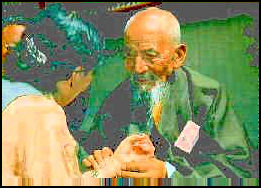
Taking the pulse
Diagnosis methods used in traditional Tibetan medicine consist mainly of interrogating, observing and touching. According to TTM theory, diseases are divided into two groups—those with heat symptoms and those with cold symptoms. Treatments include induced vomiting, clearing away heat, purgation and diuresis, medicines, acupuncture, bloodletting, moxibustion, medicated bathes and cold and hot compression. [Source: Chloe Xin, Tibetravel.org]
Ideally a doctor or healer of Tibetan medicine should be “a man of noble character, capable of immediately making the right diagnosis of a patients illness, without any examination or the least assistance.” He should preferably have at least 20 years of practice before being officially recognized as a doctor. Today, these kinds of healers and doctors are rare.
Diagnostic techniques includes listening to blood flow through the wrist, analysis of urine and anatomical parts, listening to heart and lungs, questioning the patents. Doctors are particularly on keen on checking out the 360 “subtle channels” of energy that run through the body. One Tibetan anatomical chart of the human body counted 396 bones (including teeth), divided into 23 categories, 900 tendons, 21,000 strands of hair, and 35 million pores.
Desire corresponds to disharmony of rLung (wind) with symptoms including frothy urine, a rough, dry tongue and a “jumpy” pulse. Hatred correspond to disharmony of the mKris-pa (bile), with the symptoms including yellowish-red urine, yellowish “fur” on the tongue and a “full” pulse. Ignorance cases Bad-kan (phlegm) disorders, characterized by odorless urine, thin and whitish tongue and a “sluggish” or “heavy” pulse.
Doctors feel the pulse with three fingers on each hand. A Bhutanese doctor told National Geographic, "The pulse is made of three elements, loosely translated as air, bile and phlegm. By measuring these, we can tell how the body is out of balance ad determine the cause." An Italian physician doing research in Bhutan said, "These techniques may look primitive, but they're not. These doctors have been treating the common cold with herbs for a thousand years."
Traditional Tibetan Medical Treatments
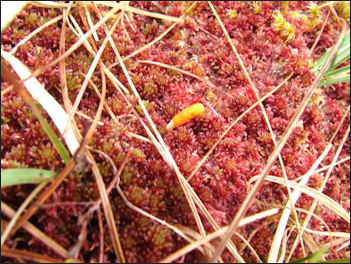
caterpillar fungusPractitioners of Tibetan medicine take a holistic approach to health and view wellness as a long term goal that can only be accomplished with a proper psycho-social environment and see treatments of symptoms as only short-term, stop-gap measures. Their treatments fall into three categories: 1) secular therapies such as medicine, diet and surgery; 2) spiritual cures, based on Buddha’s power as a healer; and 3) cures based on the dharma or teaching of Buddha.
Tibetan healers focus their attention on spiritual forces and regard medicine and medical instruments as sacred. The rituals and methods used to make medicines are regarded as just as important as the ingredients. Many illnesses are thought to be rooted in emotions and ideally can be cured by controlling these emotions. But since few of us can control our emotion we have to rely on medicines and other treatments. Tibetan medicine treatments include consultations on lifestyle and diet, meditating and reciting mantras, acupuncture and moxibustion (burning of the herb mugwort), diet supplements, and massage with special oils.
For most illnesses a physician will suggests a change of diet, lifestyle or behavior, or prescribe herbal medicines such as “dolma”, a Tibetan root with a high concentration of nutrients, currently being studied by the United States Department of Agriculture. Caterpillar fungus is highly valued in both Chinese and Tibetan medicine. It is a root food found in high passes that contains a fungus that feed parasitically on a caterpillar. It is one of the most valued things found in Tibet.
Sometimes more intrusive measures are taken. Patients with migraine headaches are sometimes treated with blood letting in which a hole is made in the patient's forehead and blood is collected in a metal pan. Arthritis is sometimes treated with a medicinal compound that is ignited over the patients skin. After the Dalai Lama's brother suffered a heart attack he was revived with branding iron singing his flesh.
Patches soaked in herbal broths are popular folk remedies in Tibet. If you have a headache you put a patch on your forehead. If you have goiter you put a patch on your neck.
Among the most widely treatments in TTM is a medicated bath. Medicated bathes, it is believed, help to dispel phlegm, resolve dampness, promote blood circulation by removing blood stasis, strengthen kidney and clear away evil heat and expel superficial evils. Such bathes are used to treat diseases such as rheumatism, rheumatoid arthritis, all kinds of skin diseases (psoriasis, ichthyosys, circumscribed scleroderma, etc.), disc hernia, hyperosteogeny, sciatica, gout, gout after delivery, varix of lower limb, hemiplegia and so on. Tibetan medicated bath mainly use savine leaves, cypress branches, Chinese ephedra, yellow cuckoo and wormwood, supplemented with more than 30 kinds of rare medical materials such as musk and snowdrop.
The three primary types of Tibetan medicated bath are: 1) liquid medicine, 2) steam medicine and 3) packing with medicine, of which the liquid medicine bath is the most common. During a liquid bath, people lay immerse their whole body or part of it in liquid medicine, which are absorbed through the skin and pass into the capillary tubes to purify the blood, soften connective tissues, dispel periosteum, provide edema-like treatments, improve the function of joints and improve immunity. Each course usually lasts seven to ten days, during which time people take a medicated bath one or two times per day (one in the morning and another in the afternoon) within strict water temperature limits that from 38 degrees to 43 degrees and last from 22 to 25 minutes. After the bath, people lie down a hot kang or stove to sweat for three to five minutes. It is said the treatment doubles the effects of the medicine and heat because the pores are more open, blood circulation is increased by removing blood stasis, and this helps dispel rheumatism and resolve dampness.
Traditional Tibetan Medicines
By one count there are 2,294 Traditional Tibetan Medicine (TTM) medicines. About 300 are widely used, with approximately 70 percent of these coming from plants and herbs; 12 percent from animals and 14 percent from minerals. One third out of the commonly used TTM medicines utilizes the same raw materials as the Traditional Chinese Medicine (TCM) and more than half of the TTM contain plants and herbs native to Tibet. [Source: Chloe Xin, Tibetravel.org]
TTM medicines are categorized in accordance to their distinct natures, tastes and functions including 8 natures, 6 tastes and 17 functions. The use of multiple medicines in a single prescription constitutes another important characteristic of TTM: some TTM contain about 25 ministerial medicines; for some others, the number of ministerial medicines even exceeds 100. In most cases TTM ingredients have substitutes if one remedy doesn’t work or some precious raw materials is too expensive or unavailable. TTM emphasizes the appropriate combination of different medicines and special attention is paid to how they are processed.
Owing to the unique geographical position of the Qinghai-Tibet Plateau and its history, TTM constitutes an integration of ancient Indian, Greek, Persian, Chinese and Arabic medicines, primarily addressing the motion balance of three factors: Long, Ciba and Peigeng. TTM is described and illustrated in the ancient text “The Town of Medicine King” of the Quadruple Medical Classics. In this text medicines of different sorts and origins are arranged in four directions of north (top), south (bottom), east (right) and west (left). Raw materials obtained beyond the Qinghai-Tibet Plateau, such as coral and crab shell from the ocean, were also included. At that time, TTM belonged to the category of Buddhist medicine and was closely associated with temples and monasteries. There was a Manbacang, or a Medical School, in many major temples and monasteries. In those temples lamas had to study the TTM for at least 10 years to be formally qualified as a doctor. This unique doctor education and training system provided an environment in which the medical lamas were not disturbed or distracted by family or other lay world affairs. Despite of incorporating a number of medical philosophies and schools, TTM itself is regarded as an independent medical school and system.
There are more than 1,000 wild plants found in Tibet used for medicine, 400 of which are medicinal herbs most often used. Particularly well known medicine plants include Chinese caterpillar fungus, Fritillaria Thunbergii, Rhizoma Picrorhizae, rhubarb, Rhizoma Gastrodiae, pseudo-ginseng, Codonopsis Pilosula, Radix Gentiane Macrophyllae, Radix Salviae Miltiorrhizae, glossy ganoderma, and Caulis Spatholobi. In addition, there are over 200 known species of fungi, including famous edible fungi songrong, hedgehog hydnum, zhangzi fungus, mush rooms, black fungi, tremellas and yellow fungi. Fungi for medical use include tuckahoes, songganlan, stone-like omphalias.
Tibetan Herbal Medicines
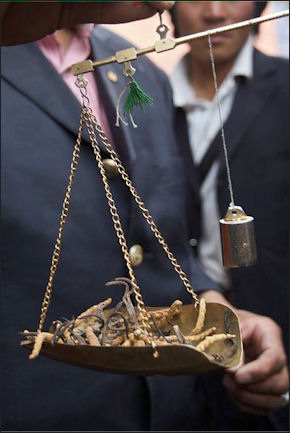
weighing caterpillar fungus Fritillary Bulb is the bulb of Fritillaria thunbergii Miq (Fam. Liliaceae). Found in Nakchu and Chamdu in Tibet, Yushu in Qinghai and Ganzi and Dege in Sichuan, it is described in Tibetan medince terms as “bitter, sweet but a little cold”. It is said to reduces fever, moistens the lungs, stimulates sputum and relieves coughs, organ inflammation, asthma, and trachitis. When externally applied, it can subdue swelling and alleviate pain. Dosage: Take 1-1.5g each time. [Source: chinaculture.org, Chinadaily.com.cn, Ministry of Culture, P.R.China, October 27, 2005]
Red orpin is mainly used as an antipyretic and a medicine for reducing phlegm. It can invigorate circulation and stop bleeding, and can help regulate the function of the nervous system and internal organs. It is also characterized by anti-caducity, anti-fatigue and promotes intellectual functions. Outer applications can help heal injuries from falls or burns. [Source: chinaculture.org, Chinadaily.com.cn, Ministry of Culture, P.R.China]
70-flavor Pearl is made of a mixture of coral, mother-of-pearl, carnelian, licorice agate, saffron, musk and other rare natural Tibetan medicinal materials. Reputed to be "a medicine that can raise the dead," it is applied to such diseases as high blood pressure, cerebral concussions, neurasthenia, hemicranias, falling sickness, paralysis, and dizziness. It is thought to be especially outstanding as a treatment for cerebral diseases and headache.
Ginseng is a kind of plant from the rose family. It is found in the highlands where the altitude is above 3,700 meters. It is rich in protein and many kinds of amino acids needed by the human body, as well as vitamin B2, B6, C, A, and E. Its most outstanding characteristics over other foodstuffs are that it contains selenium.
See Ginseng Under INGREDIENTS IN CHINESE MEDICINE factsanddetails.com
Snow Lotus
Snow lotus is a rare herb mainly found in the Qinghai-Tibetan Plateau and neighboring areas. It grows in mountain rock crevices scattered above snow level at about 4,800 to 5,800 meters above sea level. According to the Chinese government: Described in Tibetan medicine terms as bitter and warm, it is a perennial herb and grows slowly although with strong vitality. Usually, only 5 percent of seeds sprout, and the plant requires 3 to 5 years of growth to reach fruition. [Source: chinaculture.org, Chinadaily.com.cn, Ministry of Culture, P.R.China]
Due to low temperatures, with snow standing through spring and autumn, the plant must grow in harsh conditions, and sometimes tastes a little bit bitter. It is believed to enhance Yang, the essence of male energy, and regulates Ying, the essence of female activity. Natural and pure wild snow lotus flower is an antipyretic (anti-fever) and detoxifying medicine, and is usually used to help treat rheumatoid arthritis. It helps to stop aches, enriches the blood, and warms the uterus. It is also goodfor the kidneys. As a bonus, it is said to increase sexual vitality in men and can adjust menstrual difficulties in women.
Natural, pure wild snow lotus flower is an antipyretic and detoxifying medicine, and usually is used to treat rheumatism, help reduce swelling, stop aches, enrich the blood, warm the uterus, treat impotence and weak kidneys. Dosage: Take 4-8g, and soak it in white spirits or yellow wine for 10 days, before drinking 30-50ml each day. It can also be used for [detoxifying??] soup, 3-5g each time.
Caterpillar Fungus
One of the most valuable commodities in Tibet is a caterpillar fungus, an expensive traditional medicine ingredient that is touted as a cure for a number of illnesses including SARS and AIDS and treatment for everything from impotence to aging. Among those that swear by it is the basketball player Yao Ming.
Caterpillar fungus is a parasitic fungus that envelopes, kills and feeds on caterpillars. Less disgusting than it sounds, it looks like a little yellow root with a stalk growing from the top. A single caterpillar fungus can be sold by peasants for about $3 and it in turns commands as much as $10 at a Chinese medicine shop.
The main center of the caterpillar fungus trade is in Qinghai Province, particularly in the Tibetan enclave of Golog, where fungus collecting is the main source of cash. During the fungus hunting season, schools close down so children can help in the search and people with jobs take time off with visions of making big money .
See Separate Article CATERPILLAR FUNGUS (CORDYCEPS): HEALTH BENEFITS, TRADE AND MURDER factsanddetails.com
Shaman Healers in Tibet
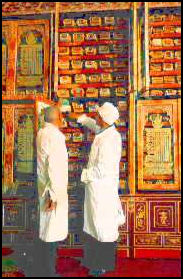
Shaman are also brought into perform exorcism and provide medical advice in many parts of Tibet and the Himalayas. Joel Ziskin witnessed shaman ritual in the Dolpa in which a blue mermaid-like demon was exorcized from a sick man by a shaman who went into a trance, howled, bent over and sunk his teeth into the man. He also saw an ailing woman treated by a lama who cauterizes a vein with a red hot iron and some herbs. She was then told that if the treatment didn't work an exorcism would be performed.
Shaman and lamas often consult dice rolled in a box when treating patients, While traveling with a sheep caravan, Eric Valli’s and Diane Summer's young daughter Sara became very ill with a high temperature. To figure out what was wrong a village doctor threw a couple of dice and pronounced that demons had seen her nice clothes and possessed her, thinking she was a rich girl. He recommended that Sara take the name of a blacksmith and wear miniature tools to trick the demons into thinking she was a member of a low caste. Seeking a second opinion, Sumner took his daughter to a monastery, where lamas donned demon masks and threw paper images of demons into a fire in attempt to exorcize the demons. It was not clear if either treatment worked, but Sara eventually recovered.
A bad chest pain is believed to be caused by an evil spirit not a disease or ailment. To appease spirts, a lama or shaman may recommend making 108 little cakes as offerings or making effigies of people who have been injured and who are ill. The effigies are throw down a gorge to fool the spirts that they are the real people, causing them to leave. In the old days when noblemen were involved, real people wearing the clothes of the injured nobleman were thrown into the gorge.
Chinese Government Support of Tibetan Medicine
There were only two medical institution in Tibet before 1959 — the "Mantsikhang" (Institute of Tibetan Medicine and Astrology) and the "Chakpori Zhopanling" (Medicine King Hill Institute for Saving All Living Beings) in Lhasa. They had a combined floor space of only 500 square meters for the outpatient clinics and a total staff of fewer than 50. They handled 30-50 outpatients a day, and mainly served the elite. [Source: chinaculture.org, Chinadaily.com.cn, Ministry of Culture, P.R.China, October 26, 2005]
According to the Chinese government: The state has allocated millions of dollars to promote the development of Tibetan medicine and pharmacology in Tibet. As of the early 2000s, there were 14 Tibetan medical institutions in Tibet, and more than 60 county-level hospitals have been established Tibetan medicine sections. In 1959, the working personnel involved in Tibetan medicine in Tibet numbered only 434, while in 1999 the number had increased to 1,071, including 61 chief physicians and associate chief physicians, 166 attending physicians and 844 resident physicians and doctors.
The "Mantsikhang" and "Chakpori Zhopanling" have been amalgamated to become the Tibet Autonomous Regional Hospital of Tibetan Medicine, with a floor space of about 100,000 square meters and a staff of 438, of whom 290 are health technicians. The hospital has 250 beds and provides free medical care for the broad masses of the Tibetan people, receiving 230,000 outpatients annually. The hospital has set up outpatient and inpatient departments, a pharmaceuticals factory, and research institutes of Tibetan medicine, astronomy and the calendar.
Due attention has been paid to scientific research and education concerning Tibetan medicine. Tibetan medical institutions at all levels are actively carrying out scientific research on Tibetan medicine, and have collected and collated nearly 100 related documents and monographs. New achievements have been made in studies relating to the history of Tibetan medicine, medical documents, pharmacological theories, medical ethics, the inheritance of the teachings of the masters, and Tibetan materia medica. Thirty-two monographs have been published, including the Four Medical Classics (Tibetan-Chinese bilingual edition), Blue Glaze, A Complete Collection of Wall Charts of the Four Medical Classics, Diagnostics of Tibetan Medicine, Newly Compiled Tibetan Medicaments and Biographies of Famous Tibetan Doctors. The College of Tibetan Medicine has trained 615 qualified personnel of various levels and categories since it was established 10 years ago. The production of Tibetan medicine has been put on a standardized, normalized and scientific administration track. The Tibetan Pharmaceuticals Factory of the Tibet Autonomous Region, one of a dozen similar factories in Tibet, has two production lines, turning out over 110 varieties of products and boasting an annual output value of 46.1 million yuan. The hospital has adopted the method of combining Western and Tibetan medicine to treat diseases, thereby enriching and developing Tibetan medical therapies and theories.
Mentsikhang, Tibetan Traditional Hospital
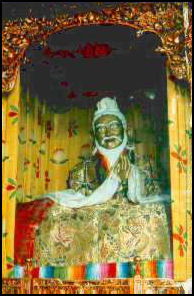
Yutok Yonten Kongpo
Saint of Medicine Mentsikhang or Tibetan Traditional Hospital is one of the most famous TTM hospitals in Tibet. Founded in 1916, it began as a regional government teaching organ in which Tibetan doctors and astronomers were trained. In 1959, the Chinese government merged Mentsekhang with another medical college, which was formerly situated on the Chakpori Hill. In this way the Tibetan Traditional Hospital and its associated Tibetan medicine factory, were established. The clinic of the hospital lies in the Barkhor Street, to the west of the Jokhang Temple. [Source: Chloe Xin, Tibetravel.org]
Numerous Thangkas, hanging on the walls of the hospital, contain the Tibetan medicinal knowledge in all of its aspects, from the beginning of Tibetan medicine, to pictures of human anatomy, to methods of treatments, dietetics, acupuncture and so on. The medical Thangkas depict them with succinct pictures and brief words. This kind of Thangka is an important tool in the teaching of Tibetan medicine. Among the diseases that are treated cranial vascular disease, chronic hepatitis, atrophic gastritis, hypertension, cardiac disease, and cerebral hemorrhages. Foreign experts and scholars come to Tibet each year to study and investigate Tibetan medicine. Some countries have even introduced Tibetan medicine to their home countries.
Like other hospitals, hospitals in Tibet are divided into several departments, such as Medical Department, Surgical Department, Dental Department, Dermatology Department, and Department of Gynecology. Some hospitals mix Tibetan Medicine, Chinese Herbal Medicine and Western Medicine together. hospitals feature in research on the unique functions of Tibetan Medicine.
Image Sources: Purdue University except Everest by Luca Galuzzi
Text Sources: 1) “Encyclopedia of World Cultures: Russia and Eurasia/ China”, edited by Paul Friedrich and Norma Diamond (C.K.Hall & Company, 1994); 2) Liu Jun, Museum of Nationalities, Central University for Nationalities, Science of China, China virtual museums, Computer Network Information Center of Chinese Academy of Sciences, kepu.net.cn ~; 3) Ethnic China ethnic-china.com *\; 4) Chinatravel.com \=/; 5) China.org, the Chinese government news site china.org | New York Times, Washington Post, Los Angeles Times, Times of London, Lonely Planet Guides, Library of Congress, Chinese government, Compton’s Encyclopedia, The Guardian, National Geographic, Smithsonian magazine, The New Yorker, Time, Newsweek, Reuters, AP, AFP, Wall Street Journal, The Atlantic Monthly, The Economist, Foreign Policy, Wikipedia, BBC, CNN, and various books, websites and other publications.
Last updated September 2022
